Sliding filament theory steps simple
Sliding Filament Theory Steps Simple. These filaments slide in and out between each other to form a muscle contraction hence called the sliding filament theory. Learn vocabulary terms and more with flashcards games and other study tools. The process is similar to rowing each myosin head rows forward using the actin as a base to pull from. Phase 1 A nervous impulse arrives at the neuromuscular junction NMJ this causes a release of a chemical called acetylcholine.
 The Sliding Filament Theory Of Muscle Contraction Four Steps Youtube From youtube.com
The Sliding Filament Theory Of Muscle Contraction Four Steps Youtube From youtube.com
The myosin head tilts and pull actin filament along so that myosin and actin filament slide each other. Myosin cross bridges fueled by ATP hydrolysis bind to the actin and rotate causing the power stroke that allows the actin to slide across the myosin molecule. ATP hydrolysis by Myosin Myosin heads contain a site for ATP binding and ATPase enzymes ATP is hydrolyzed into ADP freeing up a Phosphate molecule this energizes the myosin head. -Myosin cross-bridges flex by using the energy released by the breakdown of ATP. As new ATP attaches to the myosin head the cross bridge detaches. The sliding filament theory of muscle contraction was developed to fit the differences observed in the named bands on the sarcomere at different degrees of muscle contraction and relaxation.
The Myosin head forms a cross-bridge on the active site of the actin filament.
With a power stroke the thin actin filaments slides along the myosin. This causes the myosin binding sites on the actin to be switched on. Sliding filament theory STEP 1. The process is similar to rowing each myosin head rows forward using the actin as a base to pull from. The myosin head still remains bound to actin filament until it binds to a new ATP molecule. Phase 1 A nervous impulse arrives at the neuromuscular junction NMJ this causes a release of a chemical called acetylcholine.
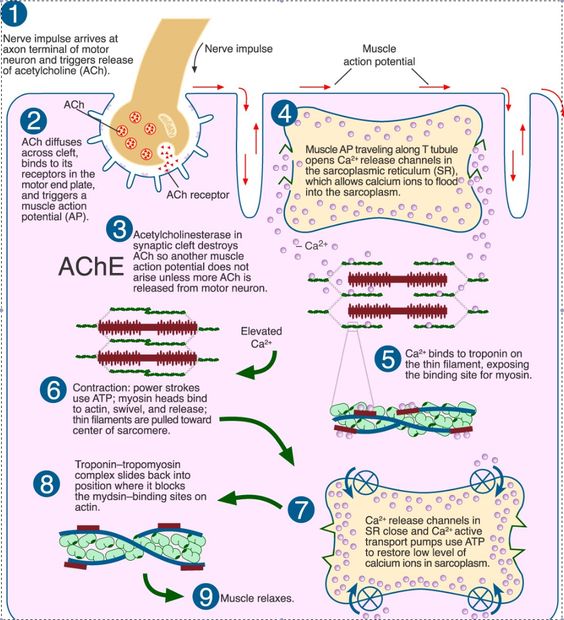 Source: onlinebiologynotes.com
Source: onlinebiologynotes.com
Steps of the Sliding Filament Theory. Myosin cross bridge attaches to the actin myofilament. The Myosin head forms a cross-bridge on the active site of the actin filament. In the sliding filament theory myosin heads attach to an actin filament bend to pull the actin filaments closer together then release reattach and pull again. The myosin head tilts and pull actin filament along so that myosin and actin filament slide each other.
 Source: youtube.com
Source: youtube.com
Myofibrils comprise of sarcomeres containing actin and myosin. In the sliding filament theory myosin heads attach to an actin filament bend to pull the actin filaments closer together then release reattach and pull again. Stage 7 In the seventh stage of the sliding filament theory of contraction the mytosin head is released from the actin filaments binding site and the binding site is covered up again. Steps of the Sliding Filament Theory. All muscles are made up of two contractile proteins called actin and myosin.
Source: quora.com
Sliding Filament Theory 2. Muscle fibres are made up of myofibrils. ADP and a phosphate group are released. The myosin head still remains bound to actin filament until it binds to a new ATP molecule. Stage 7 In the seventh stage of the sliding filament theory of contraction the mytosin head is released from the actin filaments binding site and the binding site is covered up again.
 Source: toppr.com
Source: toppr.com
Myofibrils comprise of sarcomeres containing actin and myosin. All muscles are made up of two contractile proteins called actin and myosin. Actin thin filaments combined with myosin thick filaments conduct cellular movements. The myosin head still remains bound to actin filament until it binds to a new ATP molecule. The sliding filament theory describes the process by which muscles contract.
Source: quora.com
ATP hydrolysis by Myosin Myosin heads contain a site for ATP binding and ATPase enzymes ATP is hydrolyzed into ADP freeing up a Phosphate molecule this energizes the myosin head. Remember there are 5 phases - Myosin cross-bridges flex and pull the actin filaments inward over the myosin filaments which causes the muscle to shorten. This causes the myosin binding sites on the actin to be switched on. At a very basic level each muscle fibre is made up of smaller fibres called myofibrils. As new ATP attaches to the myosin head the cross bridge detaches.
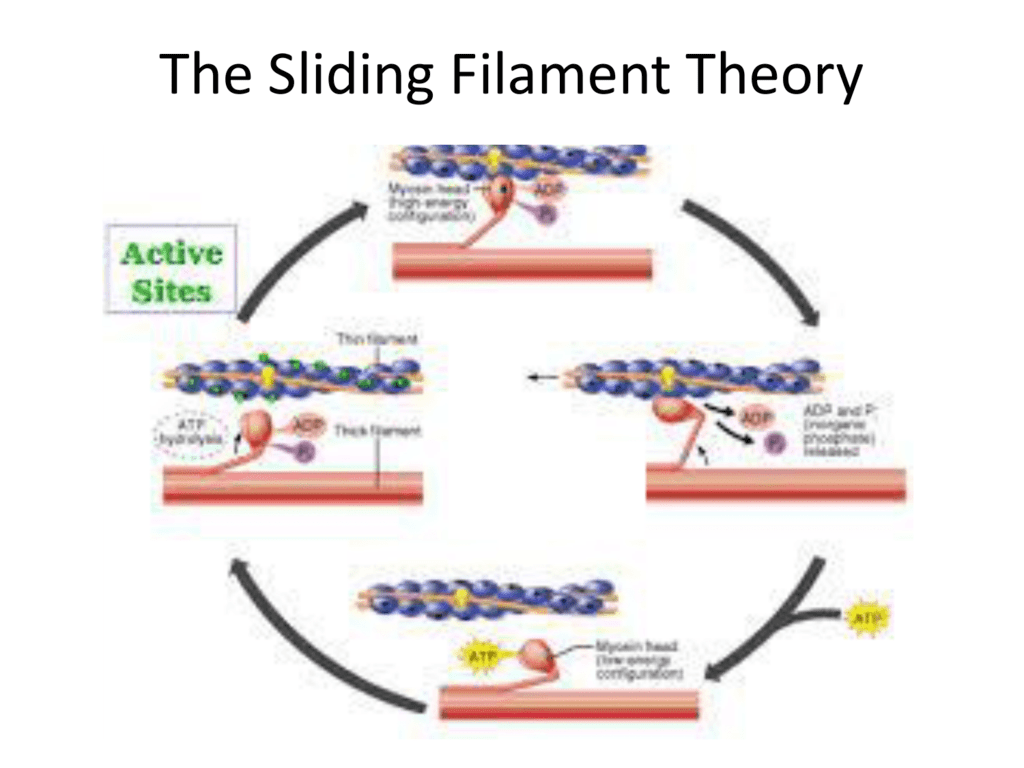 Source: studylib.net
Source: studylib.net
Myosin cross bridge attaches to the actin myofilament. The Myosin head forms a cross-bridge on the active site of the actin filament. To get the muscle to contract the actin has to be brought close together. Energy from ATP is required for the myosin head to release from the actin filamentotherwise the myosin heads would remain in the same place and the muscle would not contract. The myosin head detaches.
 Source: pinterest.com
Source: pinterest.com
Steps of the Sliding Filament Theory. As new ATP attaches to the myosin head the cross bridge detaches. In this video I break down the Sliding Filament Theory into steps to help you with studying and understanding the concepts. Sliding filament theory STEP 1. I hope you enjoyAs always leave.
 Source: quizlet.com
Source: quizlet.com
The Sliding Filament Theory and How Muscles Contract Fast Facts. Myosin cross bridges fueled by ATP hydrolysis bind to the actin and rotate causing the power stroke that allows the actin to slide across the myosin molecule. The cross bridge pulls actin which slides over the myosin known as the Power Stroke The release of ADP completes the cross-bridge movement and ATP attaches. ADP and a phosphate group are released. As new ATP attaches to the myosin head the cross bridge detaches.
 Source: youtube.com
Source: youtube.com
ADP and a phosphate group are released. Remember there are 5 phases - Myosin cross-bridges flex and pull the actin filaments inward over the myosin filaments which causes the muscle to shorten. This causes the myosin binding sites on the actin to be switched on. The sliding filament theory is a suggested mechanism of contraction of striated muscles actin and myosin filaments to be precise which overlap each other resulting in the shortening of the muscle fibre length. ATP hydrolysis by Myosin Myosin heads contain a site for ATP binding and ATPase enzymes ATP is hydrolyzed into ADP freeing up a Phosphate molecule this energizes the myosin head.
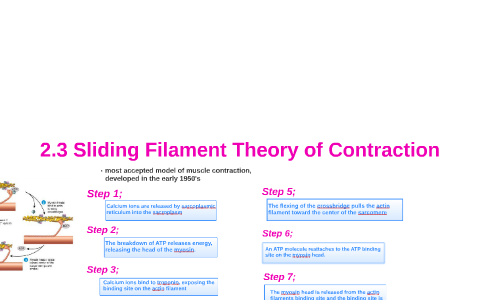 Source: prezi.com
Source: prezi.com
After sliding the cross bridge detached and the actin and myosin filament come back to original position. The sliding filament theory describes the process by which muscles contract. In this video I break down the Sliding Filament Theory into steps to help you with studying and understanding the concepts. Learn vocabulary terms and more with flashcards games and other study tools. Myosin cross bridge attaches to the actin myofilament.
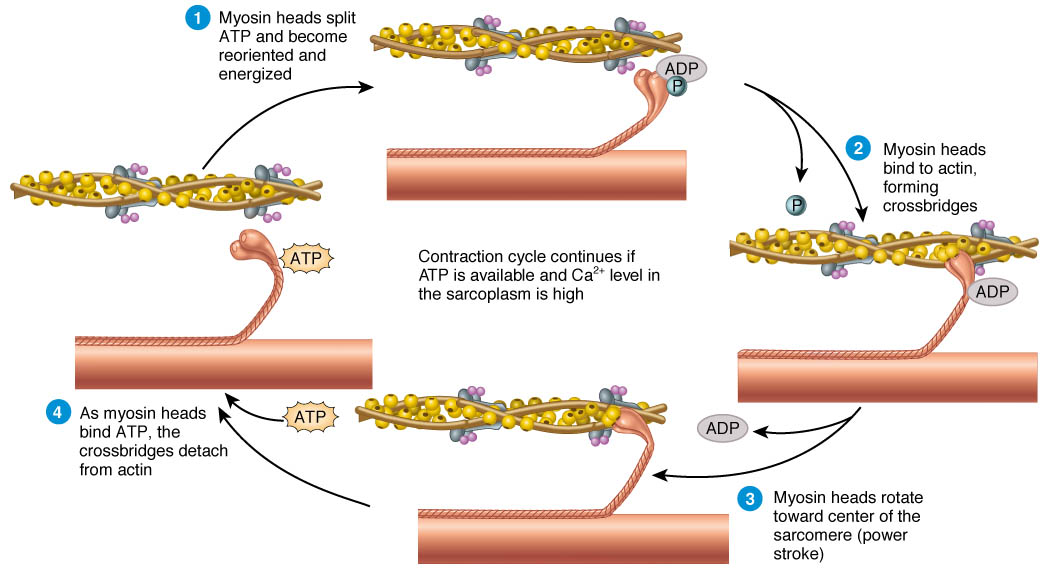 Source: thefitnesstraineracademy.org
Source: thefitnesstraineracademy.org
-Myosin cross-bridges flex by using the energy released by the breakdown of ATP. Sliding filament theory STEP 1. The myosin head still remains bound to actin filament until it binds to a new ATP molecule. Myosin cross bridges fueled by ATP hydrolysis bind to the actin and rotate causing the power stroke that allows the actin to slide across the myosin molecule. Acetylcholine causes the depolarisation of the motor end plate which travels throughout the muscle.
 Source: slidetodoc.com
Source: slidetodoc.com
At first the muscle is relaxed. The process is similar to rowing each myosin head rows forward using the actin as a base to pull from. Myofibrils comprise of sarcomeres containing actin and myosin. With a power stroke the thin actin filaments slides along the myosin. These contain even smaller structures called actin and myosin filaments.
 Source: quizlet.com
Source: quizlet.com
The mechanism of contraction is the binding of myosin to actin forming cross-bridges that generate filament movement Figure 1. I hope you enjoyAs always leave. ADP and a phosphate group are released. The myosin head tilts and pull actin filament along so that myosin and actin filament slide each other. 1 A nerve impulse arrives at the neuromuscular junction releasing acetylcholineDepolarisation continues down the t-tubules causing Ca2 release.
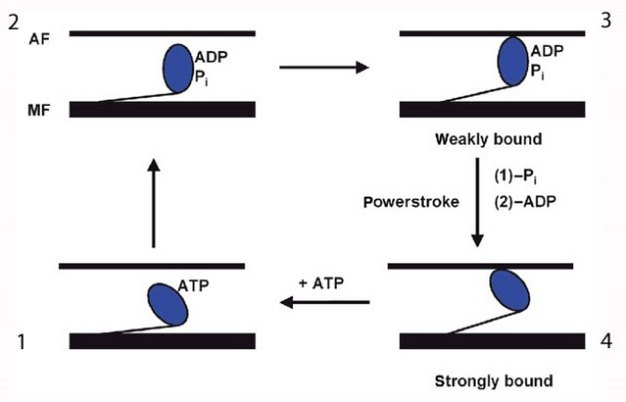 Source: nature.com
Source: nature.com
ADP and a phosphate group are released. Groups of actin and myosin form myofibrils which group together to form a muscle fiber which group together to form. The cross bridge pulls actin which slides over the myosin known as the Power Stroke The release of ADP completes the cross-bridge movement and ATP attaches. -Myosin cross-bridges flex by using the energy released by the breakdown of ATP. Energy from ATP is required for the myosin head to release from the actin filamentotherwise the myosin heads would remain in the same place and the muscle would not contract.
 Source: pinterest.com
Source: pinterest.com
Myosin cross bridge attaches to the actin myofilament. This causes the myosin binding sites on the actin to be switched on. The mechanism of contraction is the binding of myosin to actin forming cross-bridges that generate filament movement Figure 1. After sliding the cross bridge detached and the actin and myosin filament come back to original position. To get the actin together the myosin has cross bridges which pull them near each other but the actin has proteins tropmyosin and troponin which stop the cross bridges from pulling them together.
If you find this site beneficial, please support us by sharing this posts to your own social media accounts like Facebook, Instagram and so on or you can also save this blog page with the title sliding filament theory steps simple by using Ctrl + D for devices a laptop with a Windows operating system or Command + D for laptops with an Apple operating system. If you use a smartphone, you can also use the drawer menu of the browser you are using. Whether it’s a Windows, Mac, iOS or Android operating system, you will still be able to bookmark this website.






